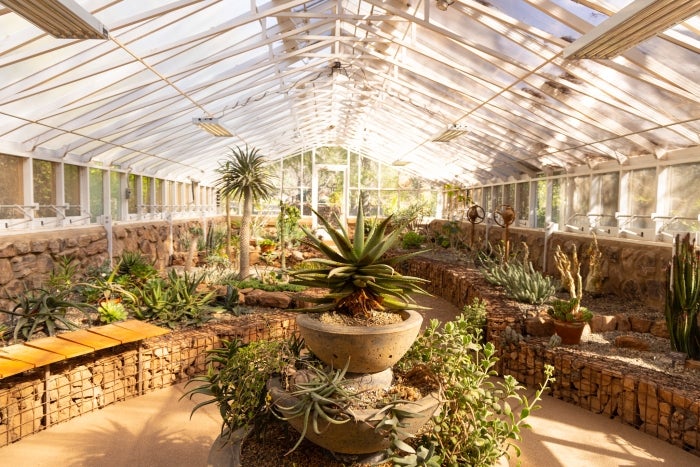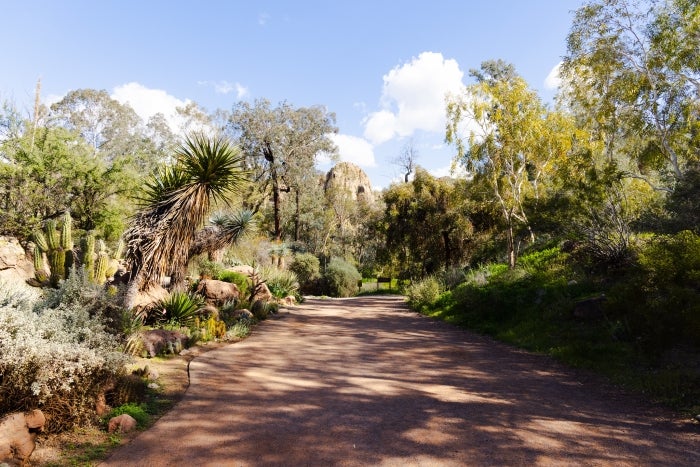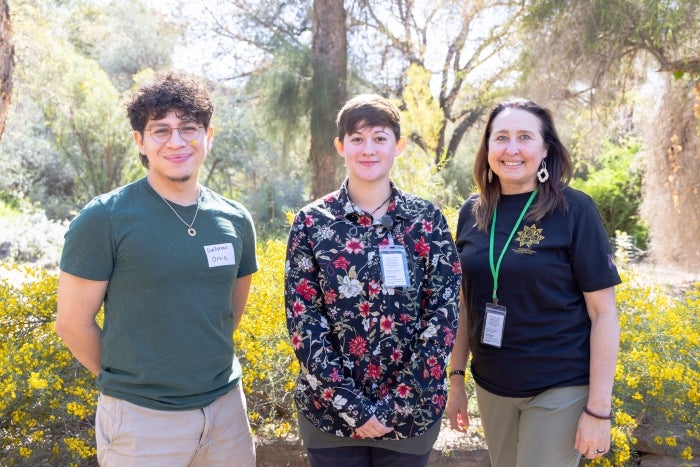ASU helps document history, implement new technologies for 100-year-old botanical garden

Purple blooms in the Hummingbird and Butterfly Garden at the Boyce Thompson Arboretum. Photo courtesy Meghan Finnerty/ASU
Earth Day is every day for the Boyce Thompson Arboretum, but this year is especially significant as it celebrates its 100th anniversary. Arizona State University is working with the arboretum on several innovative projects to document Arizona’s oldest and largest botanical garden.
The partnership with ASU is symbiotic, to use a biology term. The arboretum provides one-of-a-kind, hands-on experiences with desert plants, wildlife and ecosystems, and in turn, students, faculty and staff at ASU have helped develop resources and research that will keep the desert oasis blooming for centuries to come.
From desert plant research and conservation, to oral histories and archives, to immersive digital learning and advanced GIS mapping, current projects and programs span across the humanities, natural sciences and social sciences disciplines.
Decades of stories to tell
As part of the centennial celebration, the School of Historical, Philosophical and Religious Studies public history program partnered with the Desert Humanities Initiative to document oral histories and digital archives of the arboretum.
The project, led by Associate Professor Mark Tebeau, Program Coordinator Erin Craft, graduate student Holly Barnard and alumni Taylor Bangerter and Mike Wohl, gave students the opportunity to interview dozens of employees, board members, volunteers and patrons of Boyce Thompson.
“What (the students) spoke about often was how almost every single person we interviewed really was connected. So not just, this is my job, this is what I do, but this is my place,” Craft said.
“And they all had stories about their favorite areas of the arboretum or the plants that they loved.”
Mayor of Superior, Arizona, Mila Besich, who was interviewed as part of the project, shared her love for the arboretum and her fond memories of growing up nearby.
She recounted the Telegraph Fire of 2021 and how she was part of the response team that contacted Sen. Mark Kelly to make sure the arboretum was saved. The fire lasted almost a month and burned over 180,000 acres, the second largest wildfire in the U.S. for that year.
Students also worked with the Boyce Thompson library to create a digital archive of its many artifacts.
“Anytime we could be at the arboretum and we weren't conducting oral histories, we were in there creating a finding aidA finding aid is an organizational tool containing detailed, indexed information about a specific archival collection. , getting a grasp on the huge amount of stuff that was back there,” Wohl said.
Boyce Thompson is at the heart of Pinal County. ... It's fundamental to that county and its history. And so documenting this place is vital to understanding not just Boyce Thompson, but its surroundings and its relationship to them.
Erin Craft
The students dug through thousands of documents, including botanical literature, educational posters, personal records, letters, maps and endless stacks of slides and photographs. Along the way, they discovered even more stories about the arboretum, many of which outlived those collected through the oral histories.
For example, they read about Fred Gibson, who was an instructor of plant pathology and was offered the job of leading the arboretum by Colonel Boyce Thompson in 1924, when the arboretum was founded.
This ongoing project has provided hands-on experience to students interested in pursuing careers as archivists and museum curators.
“It's on all my resumes that I've been sending out. I've got a couple applications to not only archives administrations, but some history consulting firms. I plan on using BTA for that,” Wohl said.
Future work will involve mapping human-environment interactions and creating public-facing art programming to highlight the arboretum.
“Boyce Thompson is at the heart of Pinal County, a county that is rural, poor and doesn't get a lot of love,” Craft said. “It's fundamental to that county and its history. And so documenting this place is vital to understanding not just Boyce Thompson, but its surroundings and its relationship to them.”
Immersive technology for increased access
In addition to the historical archive, an interdisciplinary team at ASU is currently creating an immersive online course exploring the history, ecology, geology and botany of Boyce Thompson Arboretum and the town of Superior.
With funding from Shelley Esque and Lenni Benson, they will use place-based software to create high-definition, 360-degree digital learning environments.
Students will be able to navigate through the digital space embedded with layers of textual, video and audio resources. They will engage with the platform to explain and account for how plants, humans, animals, climates and technologies have shaped the area’s history.
The project team includes Professor Jason Bruner, Associate Professor Evan Berry, Professor Steven Semken, Associate Professor Erika Lynne Hanson, Graduate Teaching Assistant Luke Ramsey and Regents Professor Jonathan Bate. Together, they bring expertise in geology, art, history, sustainability and environmental humanities.
"There's just a lot to think about in a pretty tight area geographically speaking,” Bruner said.
“It makes sense to try and get a botanist and a geologist and an artist and historian and so on together, and sort of in one way model for students how to think together about what it means to be in a place and to think with these different kinds of disciplinary tools and perspectives, appreciating different kinds of connections that each of any of those disciplines or practices and methods would bring.”
Semken, an ethnogeologist and geoscience education researcher whose work focuses on place-based and culturally informed geoscience education, has led geology hikes for several years as a volunteer at the arboretum.
“If you look at Superior as a whole, it’s got interesting and instructive geology in terms of the fact that a large piece of Arizona’s geologic history is encapsulated in the rocks in that area,” Semken said.
“Both places are geologically illustrative and rich, and my role is to help expand that place-based education, develop it, assess it and teach it better.”
The course will be offered to students through The College’s culture, technology and environment bachelor’s degree program, which launched for immersion students in fall 2023 and will launch online in fall 2024. The digital environment will also be made available to Boyce Thompson employees and volunteers for training and continuing education.
“This is supposed to be a virtual, asynchronous course, so we want to create authentic virtual learning experiences out there at the arboretum and out there in the Superior area,” Semken said.
“Traditionally, place-based education has been actually outdoors, or physically in person in a place, but now we are resorting more to virtual modalities to give us a chance to bring students to places where maybe they wouldn't have been able to go before.”
A game changer for hikers and horticulturists
In coordination with the 100th anniversary, Irina Chen, Yunru Lu and Amarchandra Yadavalli, who are now graduates of ASU’s master’s program in geographic information systems (GIS), used GIS tools to map the arboretum’s grounds.
They walked the trails during the hot Arizona summer and created geographic data for features like valve boxes, filters, water features, drinking fountains and more. In total, they documented 333 items on two of the main hiking trails.
“We prioritized the type of data that they wanted to be collected, like different irrigation and electrical data. It wasn’t a lot of data, but what was collected was important,” Yadavalli said.
The web map includes detailed information on location, sources and sizes for each item and allows users to interact with features on the map, including measuring distances between points as well as adding and deleting items.
“For a student, especially in a one-year program, it’s rare to get real fieldwork experience. We usually only learn and practice in front of the computers,” Lu said.
“I didn’t know much about Boyce Thompson before this, and it’s amazing, and they were extremely helpful and passionate about the work.”
Before this project, mapping of the arboretum had not been updated since the early 2000s.
“When I began here over two years ago, I asked, as a horticulturist in the area I'm taking care of, is there a map? I'd like to know where the valves are and where the clean outs are and all of that information, and there wasn't,” said Boyce Thompson Horticulture Program Manager Mary Villarreal. “And so just for staff, it's a useful tool to have and have it accessible because GIS is an online program.”
The project and advanced software lay a foundation for further mapping developments, such as clearly indicating the difficulty and accessibility of hiking trails for visitors. The Benson family has funded several paid internships for students to gain fieldwork experience and take part in digital mapping of the arboretum.
Critical funding for student research
Though the arboretum has existed for 100 years, its official partnership with ASU launched only in 2022. Still, many students in The College of Liberal Arts and Sciences at ASU have already benefited from the partnership, especially graduate and doctoral students who are eligible to apply for the Bernard “Bill” Benson Research Award.
Arina Melkozernova, an instructional designer at ASU, is studying sunflowers and the connection between their native place and the Indigenous peoples who have preserved them. She just passed her defense this spring for her PhD in comparative culture and language through the School of International Letters and Cultures.
“This is not about just languages of people. This is also about languages of plants,” she said. “Our mission is to preserve those gifts for the next generation.”
Guillermo Ortiz, who graduated in fall 2023 with an MS in biology, is studying lichens, a symbiotic relationship between a fungus and a photosynthesizing microbe. He is performing research at the ASU Lichen Herbarium, one of the largest collections of lichenized fungi in the U.S., and is using 3D models to track lichen growth over time.
Annie Weaver-Bryant, a third-year PhD student in environmental life sciences, is studying heat adaptation in peaches at the arboretum, where she planted 30 peach trees.
“My favorite part about growing the trees has been watching them go through all of the life stages as well as watching pollinators interact with them,” Weaver-Bryant said.
Melkozernova, Ortiz and Weaver-Bryant are each Bernard “Bill” Benson Research Award recipients, or “Benson Scholars.” On March 19, they presented their research at Discovery Day, an event that celebrated the ASU–Boyce Thompson Arboretum partnership and highlighted the research projects currently taking place.
“It’s great to see so many students benefiting already from this partnership, and it also allows us the opportunity to fulfill part of ASU’s charter, which is to assume responsibility and provide stewardship and support for our local communities,” said Kenro Kusumi, dean of natural sciences at The College.
“Boyce Thompson Arboretum is such an important part of our community, historically, biologically, geographically and otherwise, so it’s exactly in line with our mission that we support their efforts now, and we hope to continue to expand this partnership in the future.”
More Environment and sustainability

A 6-month road repair that only takes 10 days, at a fraction of the cost? It's reality, thanks to ASU concrete research
While Arizona’s infrastructure may be younger than its East Coast counterparts, the effects of aging in a desert climate have begun to take a toll on its roads, bridges and railways. Repairs and…

Mapping DNA of over 1 million species could lead to new medicines, other solutions to human problems
Valuable secrets await discovery in the DNA of Earth’s millions of species, most of them only sketchily understood. Waiting to be revealed in the diversity of life’s genetic material are targets for…

From road coatings to a sweating manikin, these ASU research projects are helping Arizonans keep their cool
The heat isn’t going away. And neither are sprawling desert cities like the metro Phoenix area.With new summer records being set nearly every year — 2024 was the warmest year on record for…





